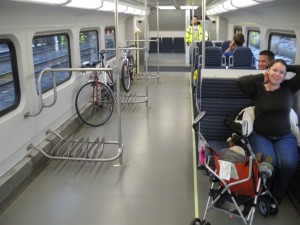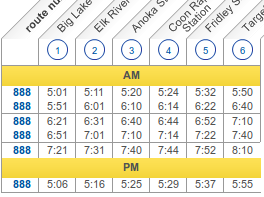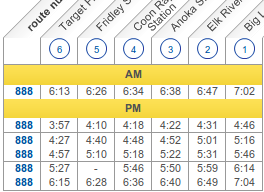This may also serve as an open letter to the Northstar Corridor Development Authority (NCDA) and the Metropolitan Council.
Northstar Commuter Rail service wasn’t designed to fail, but it’s been built that way. Rather than solely focusing on the negatives, I’d like to compare and contrast a similar system and how they’re doing things right.
Recipe for Success: FrontRunner
Let’s take a look at a successful example, that is similar to Northstar: The FrontRunner in Utah. It uses the exact same equipment as Northstar. In fact you may have seen one of the engines Metrotransit bought from the Utah Transit Authority (UTA), before it was repainted:

FrontRunner goes from Salt Lake City to Ogden, a shorter distance but with similar characteristics. At a price tag of $600M it didn’t come cheap, but I feel they did it “right” and would like to highlight the differences.
Destinations at both ends
The FrontRunner starts at the state’s capitol and largest city, and terminates in Ogden, home of Weber State University. I rode FrontRunner to Ogden during the day on a weekday while I was visiting in Utah, and most of the people riding were students bound for Weber. St. Cloud and St. Cloud State are the destination Northstar needs to get riders going in both directions.
The Northstar ending in Big Lake would be like FrontRunner ending in Layton, UT – another sleepy bedroom community. The only people bound for Big Lake are residents on a return trip, that is if you can get them to ride in the first place.
Bicycle Friendly Too
After several complaints about bicycles crowding the train, UTA had some cars modified to very nicely accommodate multi-modal riders looking to use bicycles to reach their final destination:
You’d think that in a city that is the #1 bike-friendly city in America, we would have accommodations like that. But I guess we need to get more people on the train, before we see more bikes.
Additional Track
Most of Northstar’s current cost lies in stations, rolling stock, and operating expenses – not track. Otherwise the track owner, Burlington Northern Santa Fe (BNSF) holds all the cards. When I inquired to Metrotransit about over-full trains for special events, I received the following response:
Metro Transit had renegotiated a new contract with Burlington Northern. One of the items in the contract is the use of 7-car trains. For many reasons Metro Transit was asked by Burlington Northern to discontinue the use of 7-car trains. Our new limit is 5.
This is probably only an issue for Vikings and Twins games and special events like the Holidazzle Parade, but it highlights a larger concern: Northstar is at the mercy of BNSF.
There is no real way to be truly free of the freight carrier, but UTA minimized the relationship by using the carrier’s right-of-way and adding extra track to the network. FrontRunner travels in Union Pacific‘s right of way, but in order to have sufficient operating freedom, UTA added entirely new single track (and some double-track) to it’s route. This allows them to run trains when they want, and how long they want.
Schedule
This is the single biggest drawback to the Northstar service as it stands. If any money is put into Northstar that is not earmarked for the St. Cloud extension, it should be to improve the schedule.
FrontRunner has a very agreeable schedule. Take a look at FrontRunner’s southbound and northbound weekday schedules, the only time more than an hour goes by without a train is for the last one – after 11PM. Since there are destinations on both ends of the route, it also makes sense for them to run the same number of trains in both directions.
On the other hand, Northstar only runs during rush hour:
I understand Northstar is strictly a “Commuter Rail” service, meant to be a convenience (and alleviate congestion) during rush hour. But it’s partly because of the restrictive schedule that people will be reluctant to ride. “What if my meeting runs late and I can’t catch the last train?” And so it goes. Ridership has been known to spike with snowstorms, but what about increasing the overall base ridership?
Northstar’s Future
I feel like the current sentiment the general public has about Northstar is that it doesn’t have enough ridership to justify the St. Cloud extension. Right now there’s a service called Northstar Link, a coach bus that riders can take during Northstar service times from St. Cloud to Big Lake.
Northstar (and the connecting Northstar Link buses) may now (legally) have to achieve certain ridership numbers before the extension to St. Cloud will be granted with any federal money. I don’t think it will never happen – but I would love to be proven wrong. People in St. Cloud are more likely to drive their cars to Big Lake and get on the train there to skip the Bus/Train transfer. As Kris Sanda, Metropolitan Council board member from Blaine, said: “People from way out my way in the hinterlands don’t know much about taking transit and transferring to buses and so on.” Then there are those who, once in the car, are just going to drive the whole way. These numbers aren’t going to be met due to the perfect storm that’s been created: a meager schedule, lack of destinations, and inconvenient transfer requirements imposed on riders, thus driving them away – and into their cars.
When construction costs are at an all time low is when we should be building infrastructure like this – a public service that everyone can use that has real benefit for both the riders and the drivers who’s traffic is alleviated. How can we fund a stadium for a team that has eight (8) home games with public money and not this? I’m a Vikings season ticket holder and I still have mixed feelings about this.
I also understand the need for limited spending. Utah – a quintessentially red state – fully funded their project with separate track-way and an amazing schedule. This shows that while they value limited government, they still see the benefit permanent public infrastructure provides to everyone. Utah’s FrontRunner helps all the worker-bees get to work, all day long.



Leave a Reply